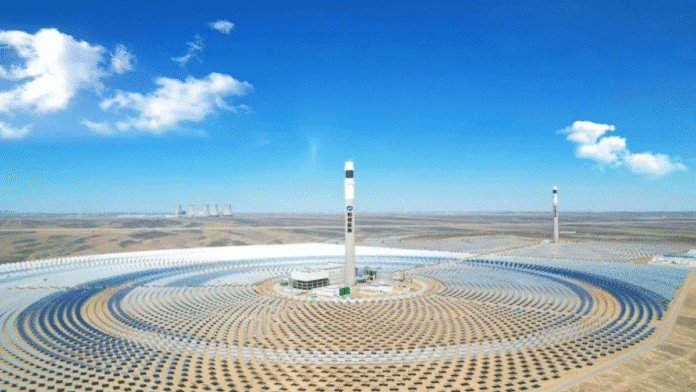🕒 Last updated on October 9, 2025
China has just turned on a world-first solar thermal power plant in the Gobi Desert, a move that could change the way solar energy is produced. This new plant is designed to be cheaper and more efficient than traditional solar thermal power stations, making it a major step forward for renewable energy.
The power station is located in Guazhou County in Gansu Province, in northwestern China. Unlike most solar thermal plants that use a single tower, this facility features two towering structures feeding a single turbine. This is the first time a dual-tower system has been used, marking a milestone in solar energy technology.
How the Plant Works
Nearly 27,000 mirrors have been set up to capture sunlight and focus it on the two 200-meter-tall towers, which are about one kilometer apart. The concentrated sunlight heats special salt to 570 degrees Celsius (1,058 degrees Fahrenheit). The molten salt then produces steam that powers a turbine, generating electricity.
One of the most remarkable features of this plant is that it can keep generating power even after the sun sets or when clouds block sunlight. The east tower collects sunlight in the morning, and the west tower takes over in the afternoon. This dual-tower design makes the plant about 25% more effective than single-tower systems.
From fossil fuels to earth’s core — new tech turns geothermal into powerhouse energy
Another advantage of having two towers is that the mirror fields overlap slightly. This design reduces the total number of mirrors needed, which cuts costs since mirrors are the most expensive part of a solar thermal plant.
Part of a Larger Energy Hub
This solar thermal plant is not working alone. It is part of a larger clean energy hub in the region, which also includes extensive solar photovoltaic (PV) and wind farms. Together, the hub is expected to supply electricity for around half a million homes every year.
Solar thermal power has one major advantage over standard solar panels: it can store heat and produce electricity after dark. This makes it a perfect partner for solar panels and wind turbines, which cannot always match energy demand when the sun isn’t shining or the wind isn’t blowing.
Trade barriers crumble as China plants $210B clean tech empire across continents
China’s Progress and Innovations
China has already built 21 commercial solar thermal plants with a combined capacity of 1.57 million kilowatts. There are 30 more projects under construction, which will add another 3.1 million kilowatts of power to the grid.
The cost of solar thermal plants has always been a challenge, mainly due to the high price of mirrors. Each mirror must be carefully curved and able to track the sun with high accuracy. To reduce costs, researchers are experimenting with special flat panels that can focus sunlight like curved mirrors, which could lower mirror expenses by up to 60%.
Globally, the largest solar thermal plant in operation is the 700-megawatt Noor Energy 1 in the United Arab Emirates. China has also contributed to major international projects in Morocco and Chile, where solar thermal power is part of national clean energy strategies.
This Gobi Desert plant represents a major engineering and technological achievement, combining innovative design, energy storage, and efficiency improvements. It shows how solar thermal power can complement other forms of renewable energy and play a crucial role in providing continuous electricity.

